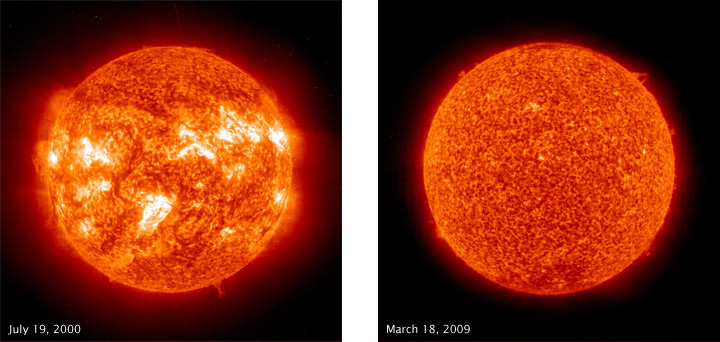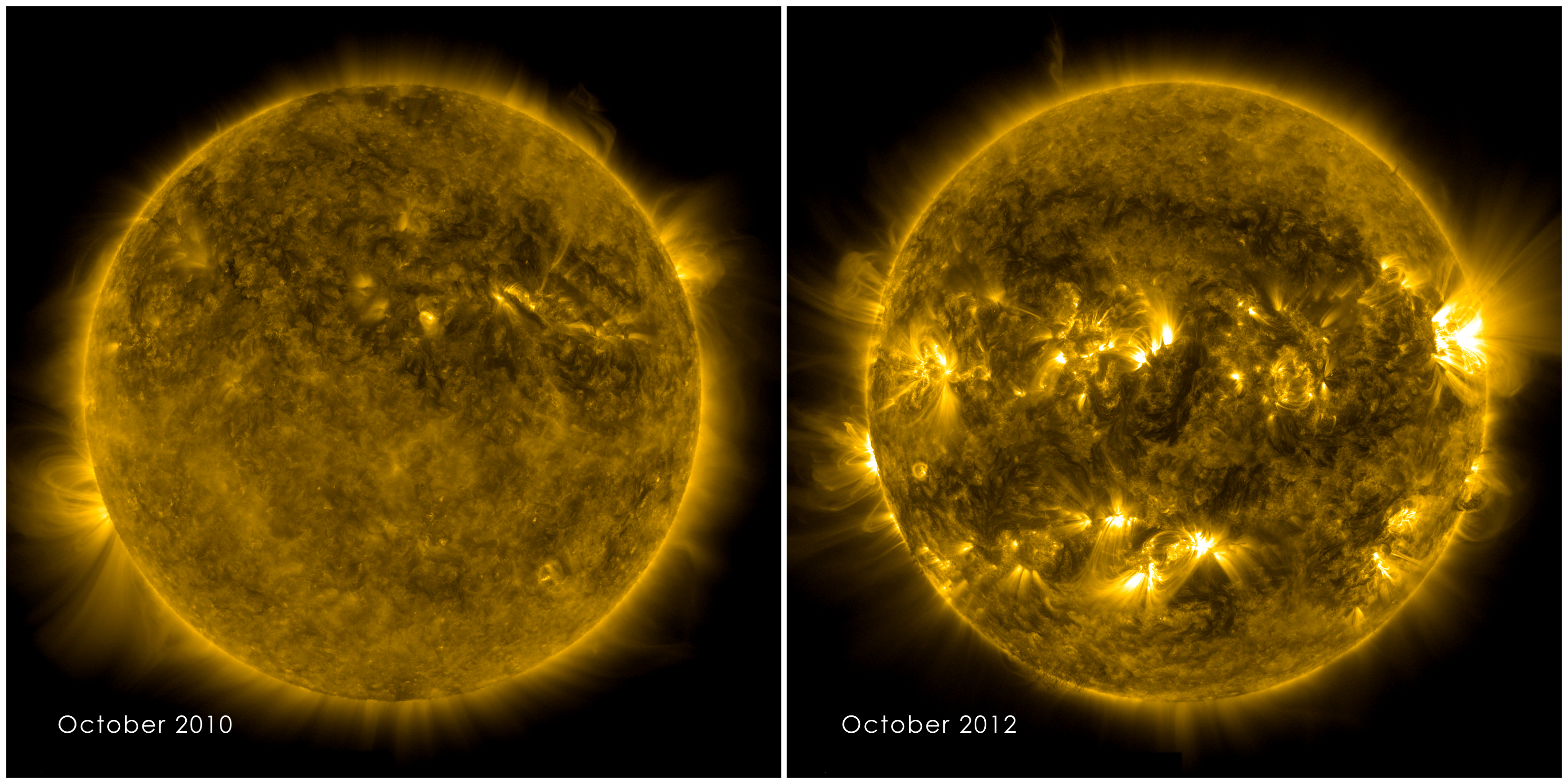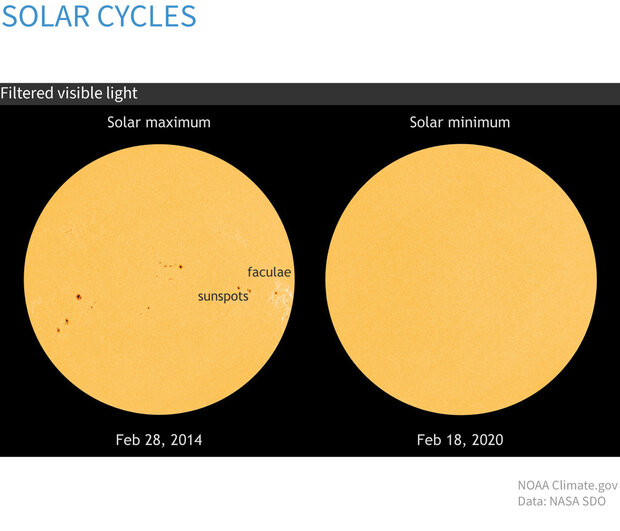Have you ever wondered why the sun sometimes seems to take a little nap, while at other times, it bursts with fiery energy? The sun goes through fascinating cycles, known as solar minimum and solar maximum, that might just hold the answers to these questions.
Understanding these cycles isn’t just for scientists or space enthusiasts; they can have real impacts on your daily life, from the technology you use to the climate you experience. So, what exactly are these solar phases, and why should you care?
Stick around, because unraveling the mysteries of the sun could change how you see the world.

Credit: www.naturalhazards.nasa.gov
Solar Activity Cycles
The sun, our closest star, is a powerhouse of energy that impacts our planet in ways we often overlook. Its activity isn’t constant; it follows cycles that astronomers call the solar activity cycles. Understanding these cycles is crucial for anyone interested in solar energy, climate change, or even satellite communications.
Solar Activity Cycles Explained
Solar activity cycles are essentially periods when the sun’s magnetic activity fluctuates. These cycles last about 11 years on average. During this time, the sun goes through phases of increased and decreased activity. These phases are known as solar maximum and solar minimum.
During a solar maximum, the sun is bustling with activity. More sunspots appear, and solar flares are frequent. It’s like a bustling city with lots of activity and noise. This increased activity can enhance the auroras you see near the poles. Have you ever noticed more news about northern lights during certain years? That’s not a coincidence.
On the flip side, during a solar minimum, the sun’s activity slows down. Fewer sunspots and solar flares are observed. It’s like a quiet countryside, tranquil and calm. This period can impact satellite operations and even power grids, making them more vulnerable to cosmic rays and space weather.
Impact On Earth And Beyond
Why should you care about solar activity cycles? Well, they affect our planet in multiple ways. Satellite communications can be disrupted during solar maximum due to increased solar flares. If you’re relying on GPS for a road trip, you might face unexpected signal issues.
Climate patterns can also shift slightly during these cycles. While solar activity isn’t the main driver of climate change, it can influence weather patterns. Do you remember a particularly harsh winter or an unusually warm summer? Solar cycles might have played a part.
Personal Connection To Solar Cycles
I vividly remember a camping trip during a solar maximum. The northern lights danced across the sky in brilliant colors. It was awe-inspiring and a reminder of how interconnected we are with the universe. Would you plan your next adventure to catch such a spectacle?
Knowing the sun’s patterns can also be essential for those invested in solar energy. Solar panels may perform differently depending on the cycle. Are you considering installing solar panels? Checking the cycle phase might help optimize your investment.
What Does The Future Hold?
How will solar cycles affect future technologies and energy solutions? As we become more reliant on technology, understanding these cycles becomes more critical. Are you prepared for the next solar maximum or minimum?
By being aware of these cycles, you can make informed decisions, whether it’s planning a trip, investing in solar energy, or safeguarding technology. The sun is always watching over us, influencing our lives more than we might realize.
Characteristics Of Solar Minimum
Solar minimum is a phase in the sun’s cycle. This phase shows unique characteristics. It offers a quieter sun with less activity. People notice changes in the sun’s behavior. Scientists observe these changes carefully.
Reduced Sunspot Count
During solar minimum, sunspots are fewer. Sunspots are dark spots on the sun’s surface. They indicate solar activity. With fewer sunspots, the sun appears calmer. This calmness affects solar observations.
Lower Solar Radiation
Solar minimum sees a drop in solar radiation. The sun emits less energy during this time. This reduction affects space weather. Satellites and other space equipment face different conditions. The decrease in radiation impacts their operation.
Impact On Earth’s Climate
Solar minimum can influence Earth’s climate. Some scientists link it to cooler temperatures. The changes in solar output affect atmospheric conditions. Researchers study these effects to understand climate patterns. This phase offers valuable insights into climate dynamics.
Features Of Solar Maximum
Solar Maximum is a fascinating phase in the sun’s cycle, characterized by several unique features. As the sun becomes more active, we observe a surge in solar phenomena that can have profound effects on Earth. Understanding these features not only satisfies curiosity but also highlights the interconnectedness between our planet and its celestial neighbor.
Increased Sunspot Activity
During Solar Maximum, sunspots become more frequent and prominent. These dark patches on the sun’s surface are cooler areas caused by magnetic disturbances. You might wonder why sunspots matter to us on Earth. More sunspots mean more solar energy output, which can affect satellite communications and navigation systems. Have you ever experienced a GPS glitch? Increased sunspot activity might be the culprit!
Heightened Solar Flares
Solar Maximum is also the time when solar flares occur more frequently. These are intense bursts of radiation from the sun’s atmosphere, capable of disrupting radio signals and power grids. Imagine planning a picnic and suddenly losing all radio contact—it’s not just a hiccup in technology; it’s a reminder of the sun’s powerful influence. Monitoring solar flares becomes crucial during this period to mitigate their impact.
Effects On Space Weather
The heightened activity during Solar Maximum significantly affects space weather. This can lead to stunning auroras, visible in higher latitudes. But it’s not all beauty and wonder; these effects can pose risks to astronauts and spacecraft. If you’re an aspiring space explorer, understanding space weather is as vital as packing your spacesuit. How prepared are we to handle these cosmic challenges? It’s a question that drives advancements in space technology and safety protocols.
Solar Maximum might seem like a distant cosmic event, but its features are surprisingly impactful on our daily lives. Whether you’re navigating with a GPS or dreaming of space travel, the sun’s activity during this phase is something you can’t ignore.

Credit: svs.gsfc.nasa.gov
Influence On Technology
Solar Minimum and Solar Maximum are phases of the sun’s cycle. Solar Minimum is when the sun’s activity is low, with fewer sunspots. Solar Maximum is a period of high solar activity, with many sunspots. These phases impact Earth’s technology, affecting satellite communications and power grids.
The sun’s cycles have more impact on our technology than most of us realize. The solar minimum and solar maximum, two distinct phases of the solar cycle, can significantly affect various technological systems we rely on daily. Understanding these influences could help us better prepare for potential disruptions.
Satellite Operations
During a solar maximum, the sun emits more solar flares and coronal mass ejections (CMEs). This increased solar activity can disrupt satellite operations by causing errors in onboard electronics. You might remember hearing about GPS inaccuracies or satellite communication blackouts—these can often be traced back to heightened solar activity. On the flip side, the solar minimum brings calmer space weather, which generally means fewer disruptions. However, satellites in low Earth orbit might experience increased atmospheric drag due to a contracting atmosphere, potentially shortening their lifespan.
Communication Systems
Have you ever experienced a dropped call or static while listening to your favorite radio station? Solar activity could be to blame. During solar maximums, high-frequency radio waves can be absorbed by the ionosphere, leading to poor signal quality. This affects not just casual conversations but also critical communication systems used by airlines and emergency services. In contrast, the solar minimum offers a more stable environment for these systems, ensuring clearer and more reliable communications.
Power Grids
Power grids might seem grounded and immune to solar activity, but they are surprisingly vulnerable. Solar maximums can induce geomagnetic storms that affect the Earth’s magnetic field, leading to voltage fluctuations in power grids. This can cause transformers to overheat or even fail, resulting in widespread power outages. During a solar minimum, the risk of such storms is significantly reduced, allowing power grids to operate more smoothly. Yet, complacency can be dangerous; even during quieter times, preparedness is key to mitigating potential risks. As you navigate your daily life, consider how these solar phases might impact the technology you depend on. Are there ways you can prepare or adapt to these changes? By staying informed, you can ensure that solar cycles don’t catch you off guard.
Environmental Implications
Solar minimum and solar maximum impact Earth’s climate differently. During solar minimum, the sun emits less energy, potentially cooling the Earth. Solar maximum increases solar activity, possibly warming the planet and affecting weather patterns. These cycles influence atmospheric conditions and natural events.
Understanding the environmental implications of solar minimum and solar maximum can provide valuable insights into our planet’s dynamic systems. During these solar phases, the sun’s activity fluctuates, impacting various environmental factors on Earth. While these changes may not be immediately noticeable in your daily life, they play a crucial role in shaping our planet’s atmosphere and climate.
Auroras And Atmospheric Changes
Solar maximum is a time of heightened solar activity. This increased activity results in more solar flares and coronal mass ejections. These events can cause spectacular auroras, commonly known as the Northern and Southern Lights, which are more frequent and vivid during this period. You might recall seeing these dazzling displays in regions closer to the poles. They occur because charged particles from the sun interact with Earth’s magnetic field and atmosphere. This interaction not only creates beautiful visuals but also affects satellite communications and power grids. During a solar minimum, the sun is quieter. This means fewer auroras and a more stable atmosphere. However, the reduced solar activity can lead to subtle changes in the upper layers of the atmosphere, influencing radio wave propagation and satellite orbits.
Potential Climate Effects
The sun’s activity also has a hand in influencing Earth’s climate. During a solar maximum, increased solar energy can slightly warm the planet. This extra energy might lead to short-term warming trends, although it is just one factor among many that affect global temperatures. On the other hand, solar minimums can lead to cooler conditions. Historical records suggest that prolonged solar minimums, like the Maunder Minimum in the 17th century, may have contributed to periods of cooler temperatures, sometimes referred to as mini ice ages. How much do these solar cycles really impact our climate compared to human activities? It’s a question scientists are exploring, balancing the natural influences of solar cycles with human-induced climate change. It’s an intriguing puzzle that reminds us of the intricate connections between space and our environment. As you ponder these cosmic influences, consider how understanding solar cycles can aid in preparing for potential disruptions. Whether it’s planning for satellite operations or anticipating climate trends, being informed about solar activity enriches your perspective on Earth’s environmental dynamics.
Historical Solar Cycle Patterns
Solar cycles have fascinated scientists for centuries. These cycles are periodic changes in the sun’s activity and appearance. Each cycle lasts about 11 years, featuring phases of high and low solar activity. The sunspot numbers vary during these phases, impacting solar radiation and Earth’s climate.
Understanding these cycles helps us predict solar behavior. It aids in anticipating potential climate effects. Let’s explore historical solar cycle patterns and what they reveal.
Tracking Past Cycles
Scientists have tracked solar cycles since the 18th century. Early astronomers noted variations in sunspot numbers. These observations laid the foundation for modern solar research.
In the past, solar cycles demonstrated consistent patterns. The cycle begins with a solar minimum, marked by few sunspots. As the cycle progresses, sunspot numbers rise, leading to a solar maximum.
Historical data helps scientists understand long-term solar behavior. Analyzing past cycles reveals trends and anomalies. This knowledge is crucial for predicting future cycles.
Predicting Future Cycles
Predicting future solar cycles is essential for planning. Scientists use historical data and complex models. These tools help estimate when solar minimum and maximum will occur.
Accurate predictions are vital for technology and climate. Solar activity influences satellite operations and communication systems. It also impacts Earth’s weather patterns and climate.
Understanding future cycles aids in preparing for potential disruptions. It ensures we can mitigate risks and adapt to changes. Ongoing research continues to refine predictions.

Credit: www.climate.gov
Frequently Asked Questions
What Is The Difference Between Solar Maximum And Solar Minimum?
Solar maximum is a period of high solar activity with more sunspots and solar flares. Solar minimum is a period of low solar activity with fewer sunspots. These cycles affect space weather and can influence Earth’s climate. Solar cycles last about 11 years, alternating between maximum and minimum phases.
How Many Years Between Solar Maximum And Solar Minimum?
The period between a solar maximum and solar minimum typically spans around 5 to 6 years. This cycle averages approximately 11 years, from one solar maximum to the next. Solar activity fluctuates, impacting solar phenomena like sunspots and solar flares during these phases.
What Happens To Earth During A Solar Minimum?
During a solar minimum, the Sun’s activity decreases, resulting in fewer sunspots and solar flares. Earth’s atmosphere cools slightly, which can affect satellite orbits. Auroras become less frequent, and cosmic rays may increase, potentially impacting technology and space missions. Weather patterns on Earth might experience minor changes.
Are We In A Solar Minimum Or Solar Maximum Right Now?
As of 2023, we are transitioning into a solar maximum. Solar activity is increasing, leading to more sunspots and solar flares. This phase typically lasts about 11 years. Solar maximums can affect satellite communications and power grids, making it important to monitor space weather closely.
Conclusion
Understanding solar cycles is important for everyone. Solar minimum and solar maximum affect our planet differently. Solar minimum brings fewer sunspots and less solar activity. During solar maximum, expect more sunspots and solar flares. These cycles influence satellite operations and communication systems.
They also impact Earth’s climate and auroras. Knowing these differences helps us prepare better. Stay informed about solar activity changes. It keeps us ready for any effects on technology and weather. Learning about the sun’s cycles enriches our knowledge of space.
